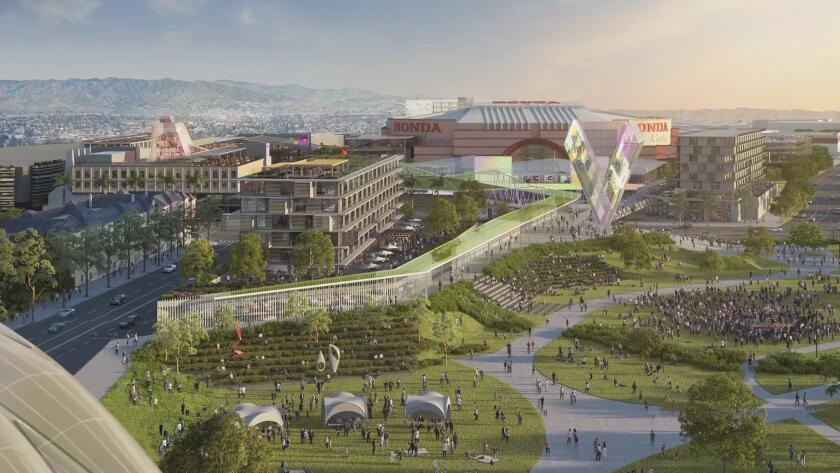Ducks submit proposal for OC Vibe, described by Anaheim official as ‘L.A. Live on steroids’
As Anaheim envisioned a colossal sports and entertainment fun zone that would stretch across a freeway and cover hundreds of acres, anchored by an arena at one end and a ballpark at the other, a city official summed up the plan in four words, easily understood by Southern Californians: “L.A. Live on steroids.”
As the Ducks’ owners toured the country, checking out sporting venues that have mushroomed into year-round entertainment centers, they paid particular attention to L.A. Live. On Wednesday, the Ducks unveiled what they call “OC Vibe,” layering a community feel atop a district that invites visitors to eat, drink and shop before and after events.
“We wanted to make this as much fun on Saturday morning as it will be on Saturday night,” said Dan Young, the master planner for the project and former president of community development for the Irvine Company.
The OC Vibe, if you will, skews mellow by day and energetic by night.
The project would integrate 2,800 apartments, including 15% reserved for affordable housing, and office space into a 115-acre site that focuses on public transit, encourages the use of trains and shared rides, and funnels cars to the margins of the property. The site flows from the Anaheim train station into one of three public parks, leading to a pedestrian bridge across Katella Avenue, a 1.5-mile footpath, and a “wellness park” in which yoga and meditation could be offered.
The Honda Center would be enhanced with a grand entrance plaza that could be used for watch parties or holiday ice skating, and the arena would be surrounded by a food hall, beer garden, restaurants, clubs and a 6,000-seat theater. The project includes two hotels, four parking structures, and a redesigned Katella Avenue off-ramp from the 57 Freeway that would lead directly into the Angel Stadium parking area, or into one of the Honda Center parking structures.
The project was submitted to the city Wednesday for various approvals, with the first openings targeted for 2024 and the completion for 2028, when the Honda Center is scheduled to host Olympic volleyball competition.
Henry and Susan Samueli, the Ducks’ owners, plan to maintain sole ownership of the project and finance its estimated $3-billion cost, Young said. He added that the Samuelis would not seek to tap the city’s general fund or ask for hotel tax rebates but could pursue government funding reserved for parks, transportation or infrastructure improvements.
Tim Ryan, who runs the Ducks and the Honda Center, said the Samuelis would continue to invest in the arena as well. He said all the seats have been recently replaced and the Ducks’ locker room has been refurbished, with additional renovations expected to be announced within three months.
While Ducks hockey is on hiatus because of the coronavirus outbreak, the Honda Center parking lot is being used as site for weddings and food distribution.
“The Honda Center will be as good as new, and in many cases better, than when it opened in 1993,” he said.
The Angels on Tuesday announced a similar live/work/play project for the Angel Stadium parking lot, targeted for completion in 2050, with double the residents and triple the office space the Ducks proposed for OC Vibe.
Young said the two teams had worked with one another to avoid duplicating development, with the Ducks’ project focused more on live entertainment. Even without the proposed concert hall, the Honda Center plays host to about 160 events in a nonpandemic year. The Angels’ project is centered around a larger neighborhood feel.
“We’re very compatible and synergistic in that way,” Young said. “We are very excited about what they’re doing over there. It will be a great complement.”
Even at the conservative count of two people per residence, the Angels and Ducks projects combined would add about 16,000 residents to the area. The projects also could draw from the crowds gathered a few blocks away at the Disney parks and at the Anaheim Convention Center. In 2019, about 24-million tourists visited Anaheim, according to Charles Harris, chief marketing officer of Visit Anaheim.
L.A. Live covers about 23 acres. The Angels and Ducks projects total 268 acres. And, to those who might scoff at the notion that Orange County can support such an ambitious scale of sports and entertainment development, Ryan said he has heard it before.
Orange County wasn’t supposed to be able to support a hockey team, he said, or a major concert venue so close to Los Angeles.
“For 25 years, we have said what is the absolute truth: With the 3-million people in Orange County and millions more just outside our borders, we have our own great market,” Ryan said. “Orange County really does want its own entertainment district.”
And just how does this district compare to L.A. Live?
“We certainly wanted to match all of the success they’ve had there,” Young said. “L.A. Live built all of the fun, and all of the restaurants, and all of the concert facilities.”
What L.A. Live did not do, he said, is secure enough land to “plan a district in as walkable a fashion as you see here.” The limited space, he said, made it impossible to integrate a residential component with an entertainment component as smoothly as the Anaheim projects propose to do.
“As you move around the country, most of the ones that have had success — and LA Live is an example — are already in an established urban fabric,” Young said. “They haven’t had [this many] acres to draw this much master planning into a site.
“That is the ‘on steroids’ portion of this.”
More to Read
Go beyond the scoreboard
Get the latest on L.A.'s teams in the daily Sports Report newsletter.
You may occasionally receive promotional content from the Los Angeles Times.








